| |
 In the northern hemisphere, January can be a gloomy month. Holiday festivities are over, the short hours of daylight and the winter weather can depress the mind and spirit. “Be Still My Soul” is a timeless well-loved sermon in song on coping with the literal and figurative winter seasons in life, and with our general circumstances in life. In the northern hemisphere, January can be a gloomy month. Holiday festivities are over, the short hours of daylight and the winter weather can depress the mind and spirit. “Be Still My Soul” is a timeless well-loved sermon in song on coping with the literal and figurative winter seasons in life, and with our general circumstances in life.
When life doesn’t go as planned, the hymn comforts us with the assurance that we have a best friend in Heaven who is all powerful, who knows what we need and will help us to become all we can be in this mortal sphere, particularly when we align our will with His. The hymn recognizes that pain is part of the mortal experience and we can learn patience and trust through it. Great strength comes from pondering the hymn’s wonderful description of heaven. The hymn’s multi-national origin is an interesting parallel to the universality of the human experience addressed by the text. The original text was written by a German poetess, translated into English by a Scottish poetess, and set to the music of a Finnish composer by a Welsh musician. The German text was originally written with six verses and is believed to have first been published in 1752 in the hymnbook titled “Neue Sammlung Geistlicher Lieder,” (New Collection of Sacred Songs) compiled by Heinrich Ernst zu Stolberg-Wernigerode, and published at Wernigerode, Germany. As shown in the photos below of an original copy of the 1752 volume from the digital library of the Martin Luther University Halle-Wittenberg, the original German text (hymn number 689) has the same basic structure as the English translation. It is interesting to note that the German Fraktur alphabet used in the printing of the hymnbook has the appearance of handwritten calligraphy, which is said to have been typical of Johann Gutenberg’s printing process invented in 1448. Irregular spacing is evidence of authentic period hand-set type, and gives an idea of the effort involved in printing a volume of over 900 hymns. 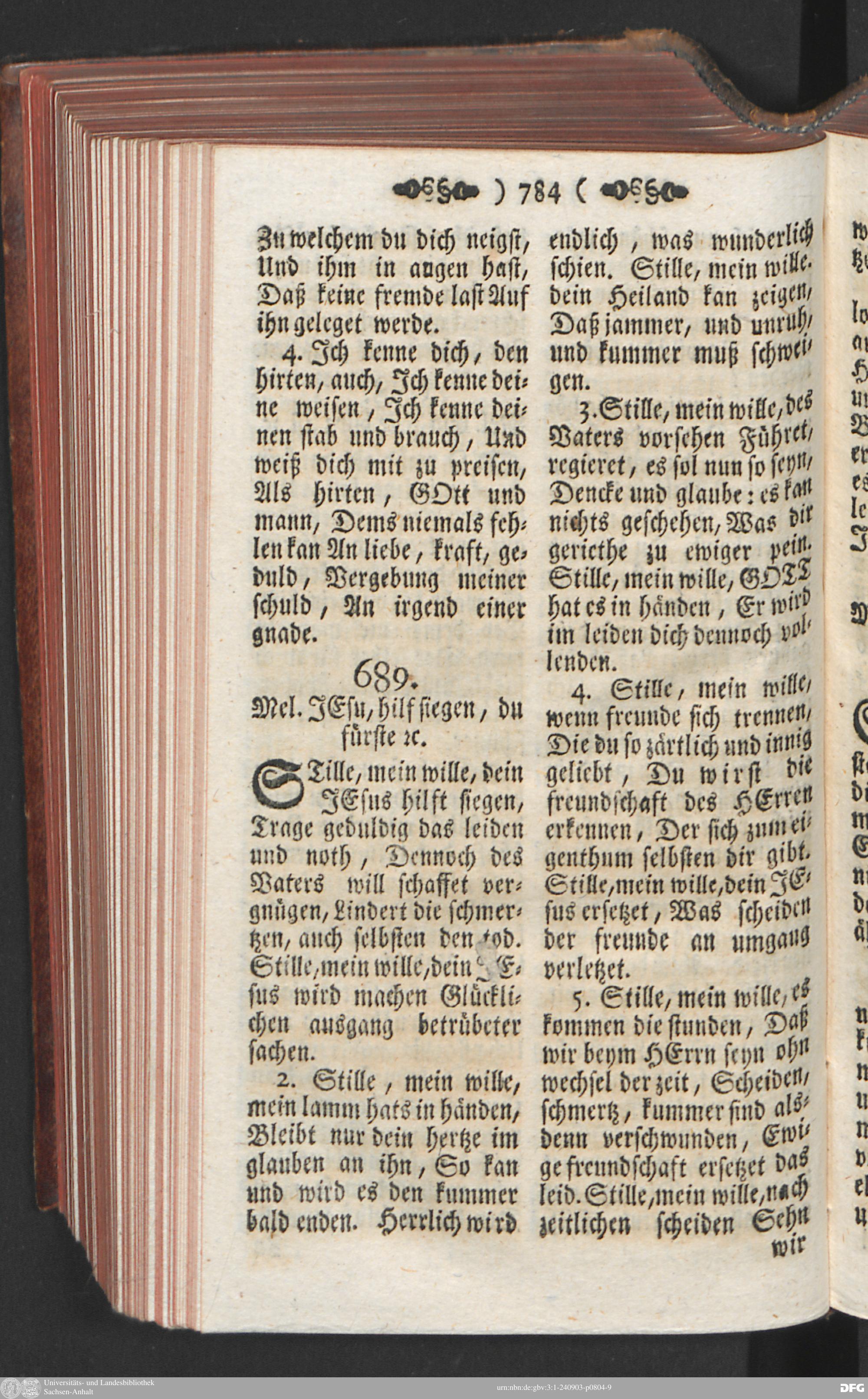
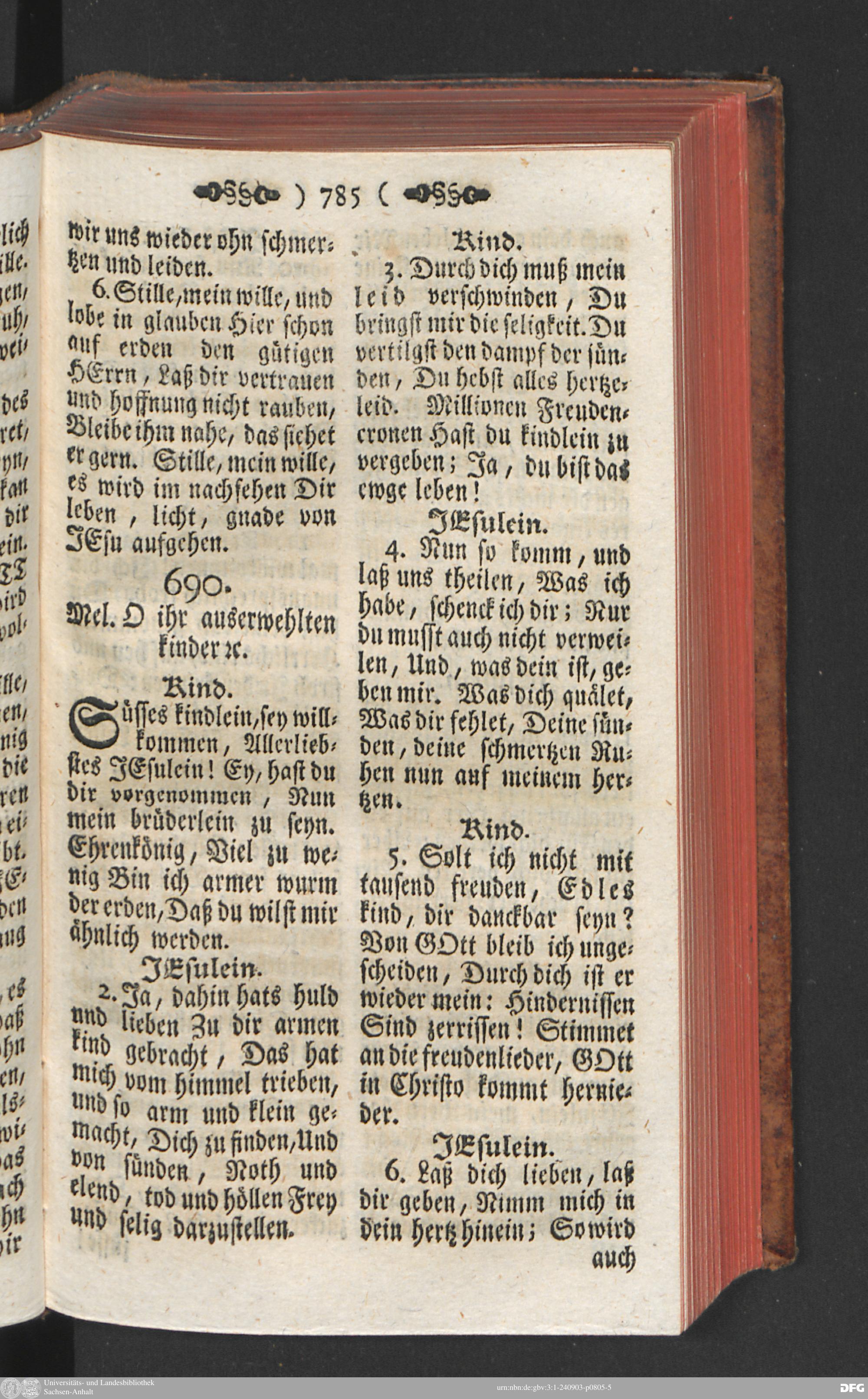
The first phrase of our hymn, “Stille, mein wille,” is not listed as the title, but gives the hymn its repeating theme and translates directly as “Silence, my will.” The correlation between ‘will’ and ‘soul’ is a significant thought to ponder. About one hundred years after the German publication, the first known English translation, titled “Submission,” was published at Edinburgh, Scotland, in an 1854 collection of German hymn translations, “Hymns from the Land of Luther.” (Photo at the top of the next column.) The translation consisted of five verses, although only three are commonly sung today. The English text that we have come to love keeps much of the original German basis of thought, rearranging some of the thoughts into different verses. This accounts for the differing number of verses from the original. To give an idea of the translator’s poetical skill, the first verse in the original German is reproduced below with an approximate direct translation in parentheses.
Stille, mein wille, dein Jesus hilft siegen,
(Silence, my will, thy Jesus helps triumph,) Trage geduldig das leiden und noth, (Bear patiently the suffering and distress,) Dennoch des Vaters will schaffet vergnügen, (Still the Father wants to create pleasure,) Lindert die schmerßen, auch selbsten den tod. (Relieve the pain, also even the death.) Stille, mein wille, dein Jesus wird machen (Silence, my will, thy Jesus will make) Glücklichen ausgang betrubeter sachen. (A happy outcome of sorrowful things.)
Some poetic license was necessary with the translation to create the English metrical structure, which has a uniform ten syllable meter with six lines in each stanza. The first phrase, “Be still, my soul” is repeated on the first and fifth lines of each verse, similar to the original German, the repetition tying the work together and emphasizing the core message.
It is evident that both the original author, Catharina von Schlegel, and the translator, Jane L. Borthwick, were well versed in the Bible. The hymn’s text skillfully weaves Biblical references in its poetical phrases. “Be still, my soul,” adapts the original German “Stille, mein wille,” using Psalm 46:10, “Be still, and know that I am God.” As in the first English verse, the concept of bearing one’s cross is found in Luke 14:27. (And whosoever doth not bear his cross, and come after me, cannot be my disciple.) A general theme of trusting in the Lord and waiting patiently for Him is found in Psalms 37:7 and Luke 21:19. (Rest in the Lord, and wait patiently for him…)(In your patience possess ye your souls.) As in the second English verse reference to the ruler of the winds and waves is found in Mark 4:39. (And he arose, and rebuked the wind, and said unto the sea, Peace, be still. And the wind ceased, and there was a great calm.) As in the fourth verse the doctrine of eternal life with the Lord is found in John 17:2-3. (As thou hast given him power over all flesh, that he should give eternal life to as many as thou has given him.) The pairing of the text with music was a matter of course. It is said that a number of tunes were used in the early years. The hymn was published in the Scottish Hymnal of 1892 and several others of that time period with a tune known as ST. HELEN, by Walter Hately. In 1927 a Welsh composer, musician and editor, David Evans, published the ‘Revised Church Hymnary’ for the Church of Scotland and affiliated churches. In his hymnal it is said he paired the text of “Be Still My Soul” to his vocal arrangement of Jean Sibelius’ symphonic poem, “Finlandia.” This is believed to have been the first publication of the completed hymn we know today. The pairing was so good, use of other tunes disappeared. Jean Sibelius recorded in a 1911 journal entry that the music for “Finlandia”’ was ‘pure inspiration,’ ‘given from above.’ Although he also said the music was never written to be sung, and was not one of his greatest works, the popularity of the music led to a number of hymn texts being set to it in addition to ‘Be Still My Soul,’ and the famous Finnish ‘Finlandia’ anthem. It is said that “Be Still My Soul” with the FINLANDIA hymn tune first appeared in the United States in the 1933 Hymnal of the Presbyterian Church. From there it spread and eventually over one hundred hymnals have included it. “Be Still My Soul” appeared for the first time in the 1985 edition of ‘Hymns, The Church of Jesus Christ of Latter-day Saints.’ The hymn remains a favorite of many people.
| | 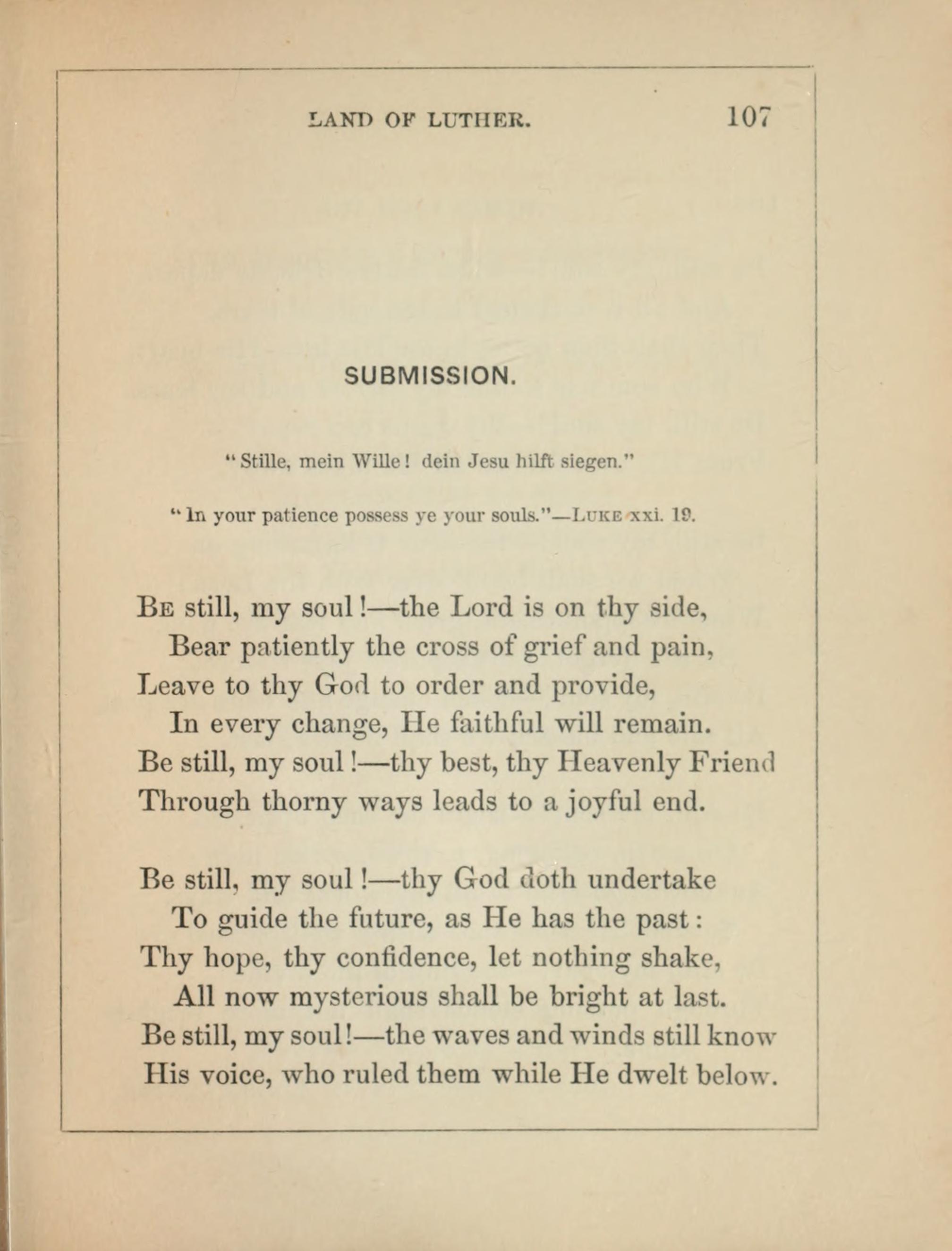 The Author, Katharina (Catharina) Amalia Dorothea von Schlegel is said to have been born in October of 1697 in Germany. Her birthplace is believed to have been Köthen (Cöthen), about forty miles northwest of Leipzig, which at the time was the capital of the independent principality of Anhalt-Köthen. It was ruled by Prince Leopold von Anhalt- Köthen from 1694 to 1728. The Author, Katharina (Catharina) Amalia Dorothea von Schlegel is said to have been born in October of 1697 in Germany. Her birthplace is believed to have been Köthen (Cöthen), about forty miles northwest of Leipzig, which at the time was the capital of the independent principality of Anhalt-Köthen. It was ruled by Prince Leopold von Anhalt- Köthen from 1694 to 1728.
It is said that Katharina may have been of an aristocratic family due to her surname, ‘von Schlegel.’ The “von” prefix is common in German aristocratic family names, which were typically tied to the name of their land holdings. However, it may also have been merely an indication of the town of her family origin, ‘von’ (from) ‘Schlegel’ (a small town in east central Germany). Katharina is believed to have been associated with a Lutheran Seminary (Stift). She is also said to have been attached to a small ducal court at Köthen, based on her correspondence with Heinrich Ernst, Count Stolberg. This is likely the same man as Heinrich Ernst zu Stolberg-Wernigerode, editor of the Hymnal in which our hymn “Stille, Mein Wille” first appeared. Katharina was born at the turn of the eighteenth century into a region divided in 1648 by the end of the Thirty Years War into loosely confederated states. The religion of each state was determined by its prince or ruler as Catholic, Lutheran or Calvinist. It is apparent that Anhalt- Köthen was Lutheran. It is recorded that Lutheranism at this time had become scholastic or intellectual, emphasizing doctrine and theology, which had been useful in contending with Roman Catholic and Reformed opponents through the Thirty Years War. However, it is said that many German Lutherans sought for a more personal expression of faith and a movement began in the country, influenced by similar movements in England and the Netherlands. This Pietistic movement stressed Bible study and personal religious experience, with emphasis on devotional practices for everyone. The word “Pious” is defined as ‘being marked by reverence for deity and devotion to divine worship.” It is said that singing of hymns was part of the devotional practice and writing of new hymns that were more personally expressive was encouraged. Katharina’s writing of “Stille, Mein Wille,” is believed to be an outcome of her involvement with this movement. It is a very personal expression of devotion and one can imagine what kind of personal experience she might have had with grief and pain. She wrote a number of other hymns as well, some published in the 1774 “Cöthnische Lieder.” However, ‘Be Still My Soul’ is said to be the only one that was translated into English and is sung today. It is interesting to note that the town of Köthen and the musically educated Prince Leopold played an important part in musical history as Johann Sebastian Bach was appointed as the Prince’s own musical director from 1717 to 1723. During his time at the court of Prince Leopold, Bach wrote his six Brandenburg concertos and “The Well-Tempered Clavier, Part 1,” as well as vocal pieces and other works. It is likely that Katharina von Schlegel, being a young woman in her twenties at the time, may have heard or been acquainted with J.S. Bach and may have been influenced by the music of the court. Katharina is believed to have lived a long and devout life, and passed away in about 1768.
“Be Still My Soul” Text as published in the 1854 “Hymns from the Land of Luther”
Be still, my soul!--the Lord is on thy side, Bear patiently the cross of grief and pain, Leave to thy God to order and provide, In every change, He faithful will remain. Be still, my soul!--thy best, thy Heavenly Friend Through thorny ways leads to a joyful end. Be still, my soul!--thy God doth undertake To guide the future, as He has the past: Thy hope, thy confidence, let nothing shake, All now mysterious shall be bright at last. Be still, my soul!--the waves and winds still know His voice, who ruled them while He dwelt below. Be still, my soul!--when dearest friends depart, And all is darkened in the vale of tears, Then shalt thou better know His love, His heart, Who comes to soothe thy sorrow and thy fears. Be still, my soul!--thy Jesus can repay From His own fullness all He takes away. Be still, my soul!--the hour is hastening on When we shall be for ever with the Lord; When disappointment, grief, and fear are gone, Sorrow forgot, Love’s purest joys restored. Be still, my soul!--when change and tears are past, All safe and blessed we shall meet at last. Be still, my soul!—begin the song of praise On earth, believing, to thy Lord on high; Acknowledge Him in all thy works and ways, So shall He view thee with a well-pleased eye. Be still, my soul!—the Sun of life divine Through passing clouds shall but more brightly shine.
The Translator
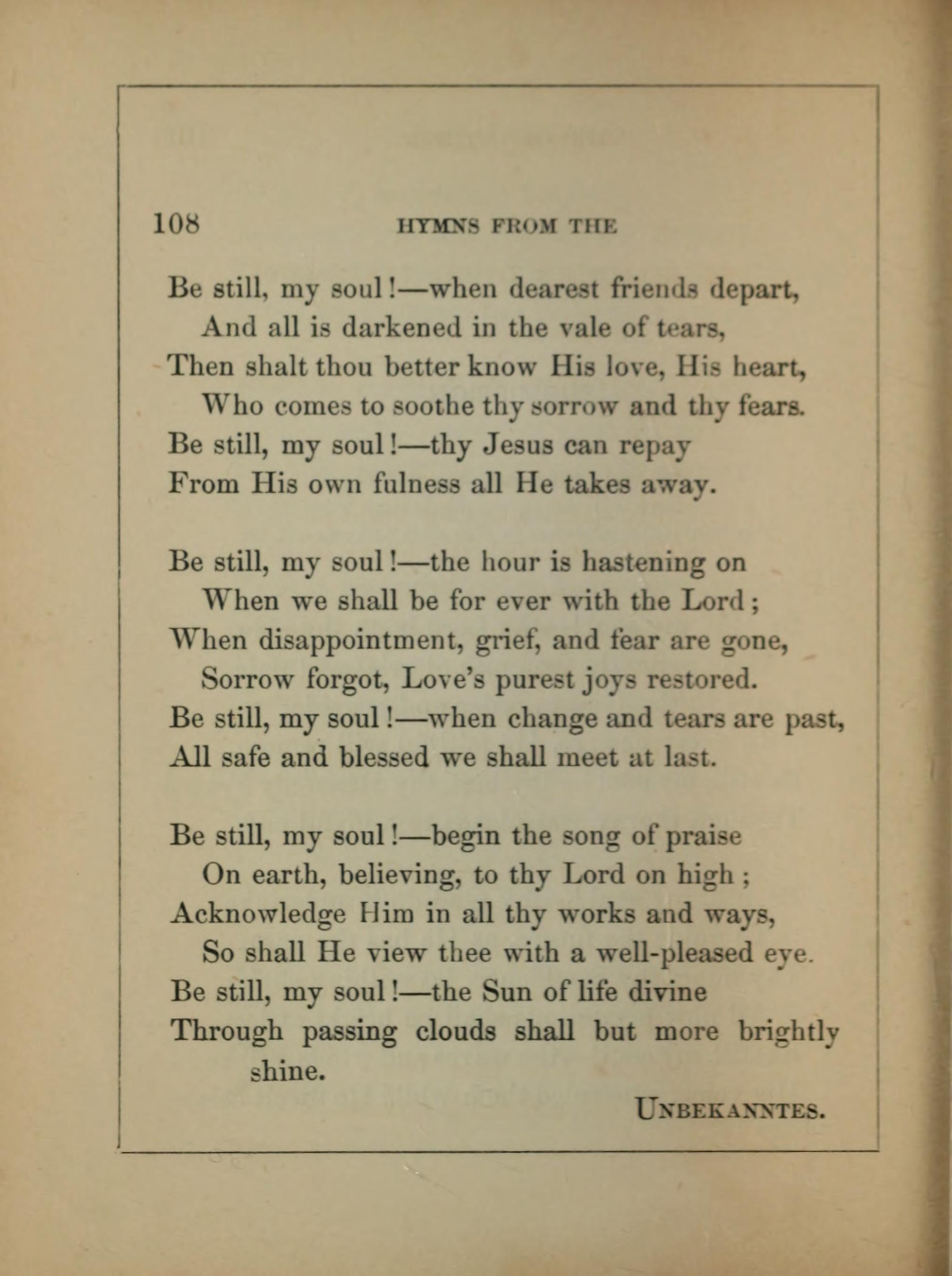 Jane Laurie Borthwick was born in April of 1813 at Edinburgh, Scotland. Her father, James Borthwick, was manager of the North British Insurance Office there. Jane had a least one sister, Sarah, who married Rev. Eric Findlater. Sarah partnered with Jane in the ambitious project of bringing the wealth of the German hymns to English speaking people. Together they translated and published four volumes of German Hymn Translations, “Hymns from the Land of Luther.” It is said that most hymnals in England and America contain some of these translations. Both sisters wrote original hymn texts also, which were widely used. A photo of an original copy of the 1854 edition page containing the beginning verses of “Be Still My Soul” is above at the top of the column, the second page is directly above. Note that the author is listed as unknown (Unbekanntes). The name Katharina von Schlegel did not appear in the original German hymnal. Neither do the names of the Borthwick sisters appear in this volume, published by W.P. Kennedy and printed at Edinburgh (viewed online at archive.org.) We trust to the great quantity of research that has been done on this hymn for the correct assignment of authorship. Jane was a published poetess in her own right, her collection, “Thoughts for Thoughtful Hours,” was published in 1857, and she contributed to other publications. It is said that she was a member of the Free Church of Scotland. This church broke away from the Church of Scotland in 1843. At this time the Church of Scotland was a state supported church and there was dissatisfaction with it. Thomas Chalmers was a passionate minister who led over 400 other ministers out of the State Church to form their own Free Church of Scotland. Among other changes, they created Sunday Schools and taught the poor to read, as well as creating a church college. Jane Borthwick was apparently engaged in this zealous ministry as it is said that she participated in mission work, publishing a book on the topic in 1872. While in Switzerland she published an additional volume of hymn translations, “Alpine Lyrics.” She was also said to be active with the Edinburgh House of Refuge. This was likely one of city’s homeless shelters. Jane Borthwick concluded her remarkable life in 1897 at the age of 84.
| |
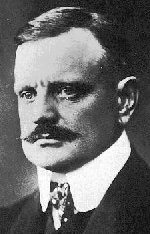 The Composer, Jean Sibelius was born Johan Christian Julius Sibelius in December of 1865 at Hämeenlinna, a small garrison town in southern Finland. His father was a medical doctor. It is said that his family called him Janne in memory of his father’s brother Johan “Janne” who had been a ship captain. Young Janne began to use visiting cards from the estate of his uncle while in his student years, the cards were written in the popular French form, and thus he became known as “Jean.” The Composer, Jean Sibelius was born Johan Christian Julius Sibelius in December of 1865 at Hämeenlinna, a small garrison town in southern Finland. His father was a medical doctor. It is said that his family called him Janne in memory of his father’s brother Johan “Janne” who had been a ship captain. Young Janne began to use visiting cards from the estate of his uncle while in his student years, the cards were written in the popular French form, and thus he became known as “Jean.”
Jean Sibelius lost his father to typhoid fever at the age of three and grew up in the home of his maternal grandmother. He learned to read music and play the piano under his aunt’s instruction at an early age and was exposed to musical performances. Finland was part of Sweden until 1809 and the dominant language was still Swedish, so young Swedish speaking Janne attended a Finnish language preparatory school before progressing to the academy. It is said he had a vivid imagination and started an orchestra with his school friends. His formal education led him to study law at the University of Helsinki but his love of music caused him to leave the University to study music at the Helsinki music academy. He later studied in Berlin and Vienna. In 1892 Jean married Aino Järnefelt and their marriage lasted until his death 64 years later. They had six children. In 1899 Finland was under the rule of Nicholas II, Emperor of Russia. In February of that year, the emperor issued a manifesto restricting the autonomy of the Grand Duchy of Finland. This stirred opposition and protests began. For celebrations in honor of the Finnish Press who were threatened by Russian censorship, a November performance of six tableaux depicting scenes from the history of Finland was presented. Jean Sibelius composed music to accompany these tableaux. Most of the music was bold and turbulent, but the last tableaux, “Finland Awakens” called for a different style, and the music we now know as “Finlandia” came to be. In 1900, Sibelius revised the music as a stand-alone piece. Living in the idyllic setting of Lake Tuusula, Sibelius composed prolifically until 1927, creating seven symphonies, an opera, over one hundred songs and other works. Interestingly, the same year he retired, the text of “Be Still My Soul” was paired with the FINLANDIA hymn tune. Jean Sibelius passed away in 1957 at his home.
The Arranger
David Evans was born in February of 1874 at Resolven, Wales, to Morgan and Sarah Evans. He attended Arnold College, Swansea and University College, Cardiff, becoming head of the music department in 1903. David was a prominent composer and outstanding University teacher, and was said to have been loyal to the traditional Welsh music institutions. He strove to raise musical standards throughout the country and his expertise in religious music was widely known. He composed a number of hymn tunes, and was chairman of the committee responsible for the editorship of the Revised Church Hymnary in which “Be Still My Soul” appeared. In 1899 David married Mary Thomas and they had two sons. He passed away in May of 1948 at the age of 74.
|